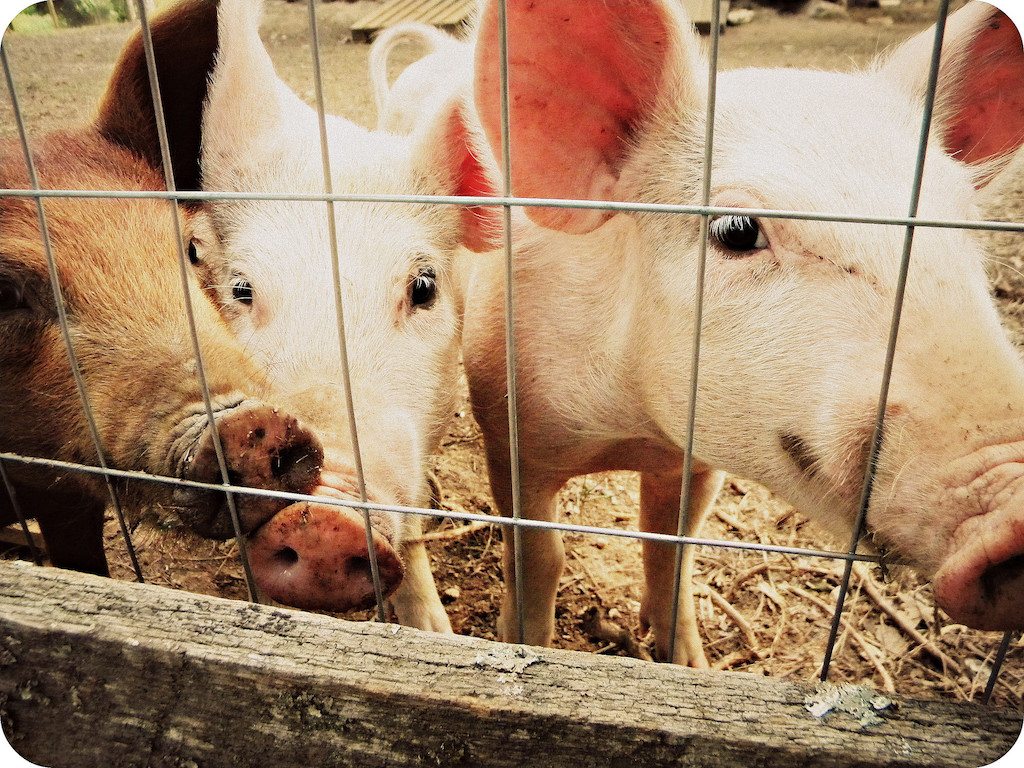Here’s a recent headline on a study published in the journal PLOS ONE that caught our eye: “Livestock-Associated, Antibiotic-Resistant Staphylococcus aureus Nasal Carriage and Recent Skin and Soft Tissue Infection among Industrial Hog Operation Workers.”
In lay language, that means a cohort of workers in the hog industry are developing antibiotic-resistant skin infections related to Staphylococcus aureus (more commonly known as staph) bacteria associated with livestock. You can see why the research grabbed our attention: New information on a relationship between staph, pigs, antibiotics, and humans? We’d be crazy not to look into it.
A bit of background: Drug-resistant staph, which includes strains like MRSA, has grabbed “superbug” headlines in recent years because it spreads in hospitals and lends itself particularly well to the “will-bacterial-evolution-outpace-medical-advance?” variety of panic. According to the CDC, at least 2 million people become infected with antibiotic-resistant bacteria every year, and at least 23,000 people die as a direct result (mostly in healthcare settings). Antibiotic-resistant infections cause alarm because they’re so hard to treat, and their existence is a reminder that we’ll need to keep developing new drugs to combat them.
Meanwhile, sustainable ag advocates have been hollering for years about “super” threats as they relate to the food system. But until now, their arguments about how “super” might manifest have been largely theoretical: “Will GMO corn breed superweeds?”, for instance, or “Will the overuse of antibiotics in livestock breed superbugs?” It’s not that the concern is necessarily unfounded. The thought of antibiotic-resistant bacteria spreading through the parts of our food supply we can’t readily see (like an industrial hog farm) is a lot more alarming than the idea of disease spreading in a geographically isolated place like a hospital, where it can be contained. But until now, GMO corn hasn’t really bred superweeds. And it’s been really hard to prove a relationship between antibiotic use in livestock and antibiotic-resistant bacteria that harms humans.
So this research could be very significant: We already knew about drug-resistant superbugs like MRSA in healthcare settings. And we already knew there was a category of MRSA associated with livestock, and that workers at hog farms can be carriers of that bacteria. What we didn’t know was whether or not the livestock-associated strains could actually make people sick. In fact, until now, there’s been doubt as to whether or not livestock-associated staph can translate to human illness at all. This research begins to make those connections.
Here are the basics: Researchers at the Johns Hopkins Bloomberg School of Public Health led a study, published in PLOS ONE this month, with data collected in late 2013 and early 2014 that tested approximately 180 North Carolina hog workers and their family members for the presence of staph in their nasal passages. Researchers also asked them whether or not they had suffered from skin and soft tissue infections in the last three months.
The results showed that hog workers who were carriers of livestock-associated staph reported recent skin infections at about five times the rate of workers who did not carry bacteria linked to animals. Not all of those infections were antibiotic-resistant—some livestock-associated staph can still be treated with antibiotics. But the workers that carried antibiotic-resistant staph were about nine times more likely to report infections than those who didn’t.
While there’s been plenty of anecdotal evidence about hog workers and skin infections, this is the first time a study of this size has yielded real data that link workers and their infections to livestock and its bacteria. Establishing that connection was one of the reasons scientists wanted a deeper look, says lead researcher Christopher Hainey of Johns Hopkins University. “We were surprised to find that there was a strong prevalence ratio for livestock-associated nasal carriage and also multidrug-resistant nasal carriage.”
It’s also important to know what this research doesn’t mean: It doesn’t mean you’re going to get a MRSA infection from eating pork, nor does it mean you should roll up the window when you pass a hog farm. It doesn’t mean that there are superbugs lurking in the shadows of the food system. But it is a kernel of evidence that confirms what doctors, community members, and journalists have been suggesting since at least 2009: that livestock-associated, antibiotic-resistant staph can lead to infections in humans. And it is, at the very least, a convincing case for more research.
 Graphic by Claire Brown
Graphic by Claire Brown Don’t expect to see a 60 Minutes episode next week with an alarming headline like “Hog workers contract drug-resistant superbugs from pigs.” Researchers have a long way to go to establish the remaining links in the chain, even if anecdotal evidence continues to pile up. And in the same way that scientists have to conclude that “we need to do more research” even in light of what seems like a huge breakthrough, we as journalists have to hold the headlines until we see a conclusive study or action from the CDC. In the meantime, however, you can bet we’re keeping an eye on the topics that intersect with this one: farmworker healthcare policy, legislation affecting the relationship between scientists and large-scale farms, and funding for public health research. Hainey put it succinctly in the study’s press release: “This issue isn’t going away.”











